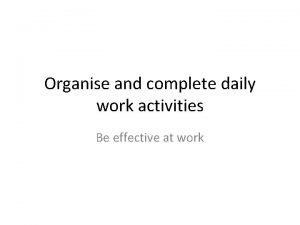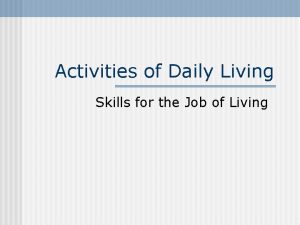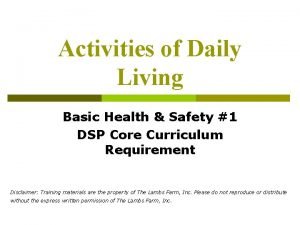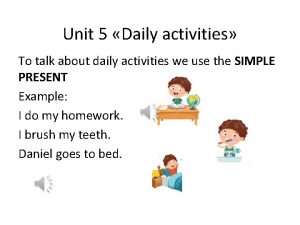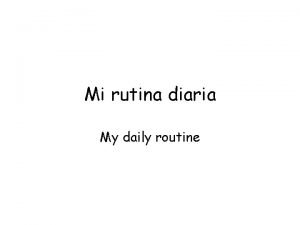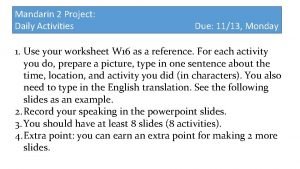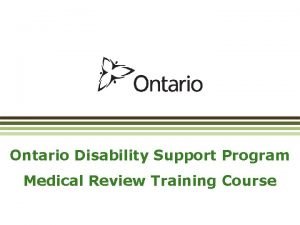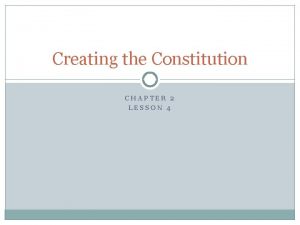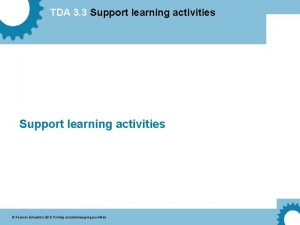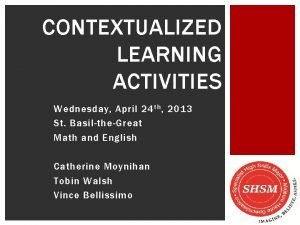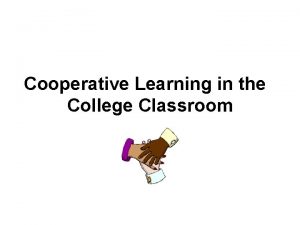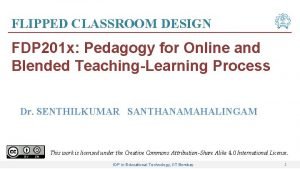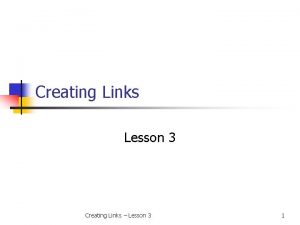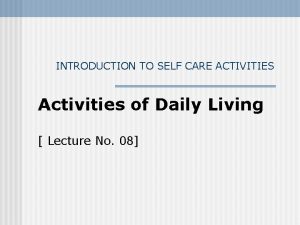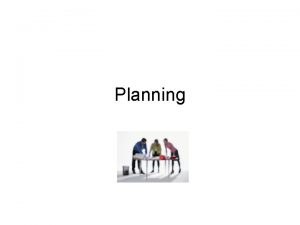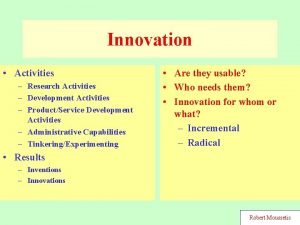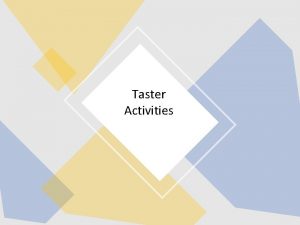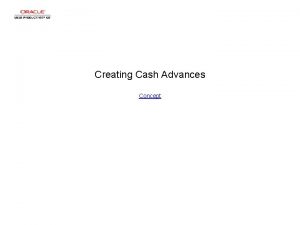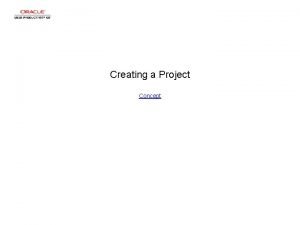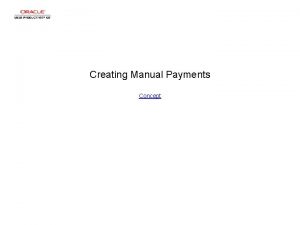Creating Daily Learning Activities Daily Lesson Planning What




![A Few Tips ● Show don’t tell! (Or tell then show [or model]) ● A Few Tips ● Show don’t tell! (Or tell then show [or model]) ●](https://slidetodoc.com/presentation_image_h2/64688e78bd1763d0235d2193b07547e2/image-5.jpg)

















- Slides: 22

Creating Daily Learning Activities

Daily Lesson Planning ● What do you want students to learn? (Goals) ● How will they learn it? (Activities) ● How will you (and they!) know? (Assessment)

Daily Lesson Plan Template Tell your students about your plans! “Here are our goals and here’s what we’re going to do today to get there” Give them updates and summaries along the way (or ask them to do it!)

Daily Lesson Planning
![A Few Tips Show dont tell Or tell then show or model A Few Tips ● Show don’t tell! (Or tell then show [or model]) ●](https://slidetodoc.com/presentation_image_h2/64688e78bd1763d0235d2193b07547e2/image-5.jpg)
A Few Tips ● Show don’t tell! (Or tell then show [or model]) ● Ask students! ● Each chapter in the textbook has activity suggestions

The Believing and Doubting Game (Peter Elbow) See A&B, pp. 22 -24, for discussion and examples. How it works: Basically, in response to an assertion, or to “a possible answer to a problematic question” (22), students write one paragraph in which they fervently try to “believe” the assertion, and then write another paragraph in which they try to “doubt” it. Students can do this alone, in pairs, or in groups. For example: “The US should reinstate the military draft, ” or “States should provide free community college tuition. ”

Why I Like It: ● It doesn’t take any special tools, other than preparing the assertion (or in another variation, have students come up with viable claims). ● It requires students to use critical thinking, exemplification, logic, even empathy. ● It can be used for different purposes: invention, planning (for classical argument, e. g. ), etc. ● It encourages dialectic and opens up discussion of the differences between claims and evidence/examples, what makes a claim believable and for whom, etc.

Debate Game - Megan ● Topic-themed (transferrable to Lit classes) ● Argumentation ● FUN! ○ They get into it ■ Really really into it ● Canvas: Resources for Teaching English 1000 > Assignments > Other Assignments

Understanding Plagiarism - Emilee ● “Beyond ‘Gotcha!’: Situating Plagiarism in Policy and Pedagogy” by Margaret Price ● It’s more often than not, a teaching moment. ● Contextualizing plagiarism ● Build a plagiarism policy as a class ● Encourages students to see the different ways that plagiarism/academic dishonesty can happen and that this is an issue that extends beyond the classroom.

Plagiarism Activity - Nuts and Bolts ● This comes from the Purdue OWL’s teacher resource page ○ https: //owl. english. purdue. edu/owl/section/3/33/ ● Takes 2 class days, usually just before we start the argumentative paper sequence. ● Have students read several examples (from news outlets), then define a series of words related to plagiarism (common knowledge, originality, own work, author, borrowing) ● As a class, create a definition of plagiarism. Then make a list of types of plagiarism (Excessive repetition, improper citation, improper idea borrowing, fraud, forgery).

The First Day ● Icebreakers ● Introduce students, yourself ● Syllabus ● Policies ● “What the class will be like” mini-class

Examples and Ideas! Pull out the outcomes sheet that you coded on Tuesday: ● Pick one outcome that you put a check next to ● Think of an example of something you do now (or have done or could do)--a lesson, activity, learning experience--that supports that item ● Share with others near you and prepare to share with the large group

Some Easy Tools for Your Toolbox ● Think-Pair-Share ● Draw/map out a response/argument/analysis/etc. (collaboratively even!) ● One pager: quotations, visual representation, personal response, thoughtful questions ● Freewrite/quickwrite ● Brainstorming: freewriting, looping, mind/clustermapping, listing, cubing, metaphors/analogies ● Pick-a-verb:

Break 10 -10: 15

Work Time

Peer Feedback Session

Lunch on your own 12 -1

Resources for supporting students

Expectations and Ongoing Professional Development

Essential Functions ● Plan and prepare for class ● Guide situations for learning ● Provide feedback ● Grade student work https: //english. missouri. edu/class/instructors-guide

Professional Development ● Goal setting ● Bi-weekly mentoring meetings ● Observations ● Pedagogical workshops and events

Q&A
 Cuadro comparativo entre e-learning b-learning y m-learning
Cuadro comparativo entre e-learning b-learning y m-learning Organize and complete daily work activities
Organize and complete daily work activities Activities of daily living assessment
Activities of daily living assessment Daily job activities
Daily job activities Basic activities of daily living
Basic activities of daily living Daily activities examples
Daily activities examples Mi rutina diaria essay
Mi rutina diaria essay Daily activities in mandarin
Daily activities in mandarin Target clientele in work immersion
Target clientele in work immersion Medical review odsp
Medical review odsp Wordwallü
Wordwallü Organize and complete daily work activities doc
Organize and complete daily work activities doc Lesson 4 creating the constitution answer key
Lesson 4 creating the constitution answer key Operating activities vs investing activities
Operating activities vs investing activities Indoor vs outdoor sports
Indoor vs outdoor sports Support activities and primary activities
Support activities and primary activities Primary activities and secondary activities
Primary activities and secondary activities Lesson 3: guidelines for eating
Lesson 3: guidelines for eating Tda 3.3 support learning activities
Tda 3.3 support learning activities Contextualized learning activity
Contextualized learning activity Example of cooperative learning
Example of cooperative learning Extended learning activities
Extended learning activities Active learning activities
Active learning activities

